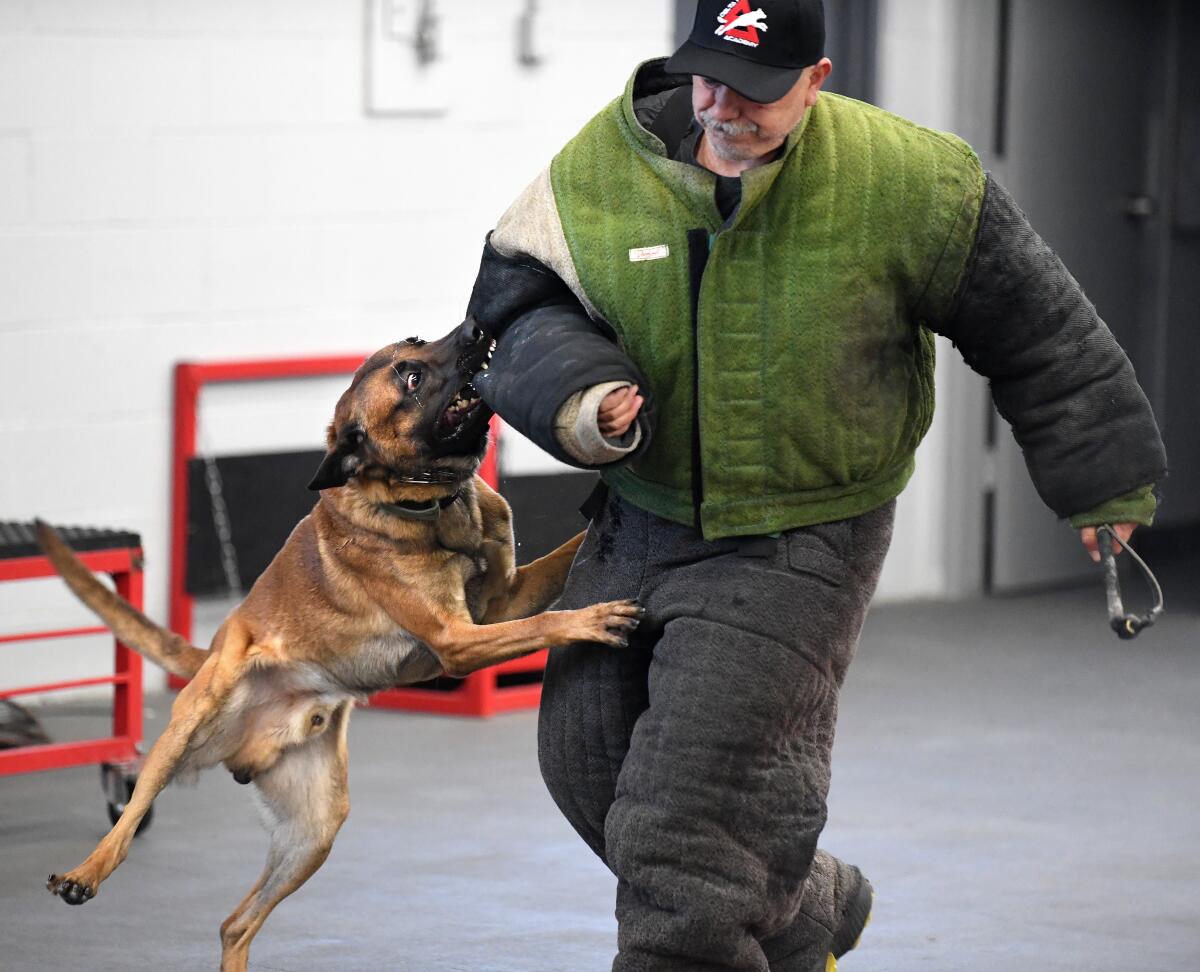There are guard dogs. Then there are $150,000 ‘canine bodyguards’

- Share via
Good morning, and welcome to the Essential California newsletter. It’s Friday, March 3.
For a growing number of L.A.’s wealthiest residents, high-tech cameras and smart alarm systems no longer provide adequate security. They’re opting for a more low-tech form of protection that’s been around since ancient times: dogs.
As my colleague Andrea Chang reported this week, protection dogs are on duty at the homes (or yachts) of professional athletes, business moguls, A-list celebrities and other affluent residents — and are now viewed as a status symbol.
They may be low tech, but the highly trained canines aren’t cheap.
“I figured maybe they’d be $10,000 or so,” Andrea told me this week. “[I] definitely wasn’t expecting to hear $45,000 to $230,000.”
But at those prices, the rich aren’t getting your typical guard dog, she explained:
They’re family pets first and foremost. They go through years of specialized training so that they’re sociable, well-adapted, good with kids and able to be taken anywhere — but they’re also capable of defending their owners should the need arise.
Concerns about rising crime — including increases in burglaries, smash-and-grab thefts at high-end stores and “follow-home” robberies — have fueled a growing interest in “personal canine bodyguards,” as some are marketed.
“It’s better at this point to have the protection dog in case something was to happen,” one woman who is training her own protection dog told Andrea. “Trust me, [criminals are] gonna want the dog bite rather than the gunshot.”
To see how these dogs are trained, Andrea visited Delta K9 Academy in North Hollywood, which breeds and trains protection dogs.
“They’ve got dozens of dogs there, from puppies to adults, and the training that they go through to become protection-level is intense,” she told me this week. “I watched the dogs learn how to properly execute bite-and-hold maneuvers, jump through windows and out of cars, and fight off aggressors.”
Many of the dogs — typically German shepherds, Belgian Malinois, Dobermans and cane corsos — are bred out of state and in some cases imported from Europe. Andrea spoke with breeders in Montana and South Carolina that run training compounds and sell their dogs for $150,000 per pup.

Trainers told Andrea there’s a misconception that protection dogs are vicious and out of control.
“Rather, the animals are bred for temperament (intelligence and stability are key) and taught to be compliant and calm under pressure,” she wrote. “The goal is an adaptable, even-keeled animal that can accompany and defend its owner anywhere.”
About 4.5 million people are bitten by dogs annually and children are the most common victims, according to the American Veterinary Medical Assn. Fatal dog attacks are rare, estimated at a few dozen in the U.S. each year.
Check out Andrea’s story and see protection dogs in training.
And now, here’s what’s happening across California:
Note: Some of the sites we link to may limit the number of stories you can access without subscribing.
Check out "The Times" podcast for essential news and more
These days, waking up to current events can be, well, daunting. If you’re seeking a more balanced news diet, “The Times” podcast is for you. Gustavo Arellano, along with a diverse set of reporters from the award-winning L.A. Times newsroom, delivers the most interesting stories from the Los Angeles Times every Monday, Wednesday and Friday. Listen and subscribe wherever you get your podcasts.
POLITICS AND GOVERNMENT
Federal regulators will allow Pacific Gas & Electric to continue running the Diablo Canyon nuclear plant beyond 2025, when the facility had initially been slated to close. Gov. Gavin Newsom contends California still needs the plant, which remains the single largest source of electricity for the state. Los Angeles Times
How many people will end up riding California’s long-planned, long delayed bullet train? Significantly fewer than previously estimated, the California High-Speed Rail Authority said in a report this week. Officials cited COVID-19’s impact on commute patterns and low population growth for falling estimates. Fresno Bee
CRIME, COURTS AND POLICING
L.A. has become a hub for illegal gambling parlors — and the crime does pay. Times reporter Matthew Ormseth explores the hidden-in-plain-sight casitas, where gamblers play electronic games and profits make their way to the Mexican Mafia. Los Angeles Times
Two Bay Area men received prison sentences this week for their plot to destroy California’s Democratic Party headquarters. Ian Benjamin Rogers of Napa and Jarrod Copeland of Vallejo were sentenced to nine years and 4½ years, respectively. The two men planned a bombing attack at the Sacramento building on the day of President Biden’s inauguration, sparked by former President Trump’s false claims of election fraud. Los Angeles Times
Police in San Diego want their access restored to hundreds of streetlight cameras and to add hundreds more, plus license plate readers, on local streets, which would make it the largest U.S. city to roll out the surveillance as a single network. Community members will get to weigh in before anything is decided — and it was public outcry that pressured the city to cut off access to the tech in 2020. San Diego Union-Tribune
Support our journalism
HEALTH AND THE ENVIRONMENT
Thanks to the remarkably wet winter weather, more than half of California is no longer in a drought. That’s the assessment from the National Oceanic and Atmospheric Administration in its latest Drought Monitor report. About a quarter of the state is still categorized as being in severe drought. Los Angeles Times
Pandemic food benefits are ending for nearly 3 million California households. With experts warning that food insecurity will get worse, it’s unclear what Newsom and state lawmakers will do. Los Angeles Times
CALIFORNIA CULTURE
Are themed restaurants making a comeback? My colleague Todd Martens visited a steampunk chocolate emporium staffed with robots (well, humans in robot costumes) and explored the history of establishments that go all in on a motif. Los Angeles Times
For EV drivers, range anxiety is real. The San Francisco Chronicle created a tool to help road trippers gauge how far Teslas and other electric cars can get them between charges. San Francisco Chronicle
Free online games
Get our free daily crossword puzzle, sudoku, word search and arcade games in our new game center at latimes.com/games.
AND FINALLY
Today’s California landmark comes from Arthur Litman of Culver City: the elephant seal hangout off Highway 1, just north of San Simeon.

Arthur writes:
[It’s] so satisfying to see the elephant seal population recovered and lounging away in the sun. I could stand there for hours just watching them cover themselves in sand and watch their interactions.
What are California’s essential landmarks? Fill out this form to send us your photos of a special spot in California — natural or human-made. Tell us why it’s interesting and what makes it a symbol of life in the Golden State. Please be sure to include only photos taken directly by you. Your submission could be featured in a future edition of the newsletter.
Please let us know what we can do to make this newsletter more useful to you. Send comments to essentialcalifornia@latimes.com.
Sign up for Essential California
The most important California stories and recommendations in your inbox every morning.
You may occasionally receive promotional content from the Los Angeles Times.




